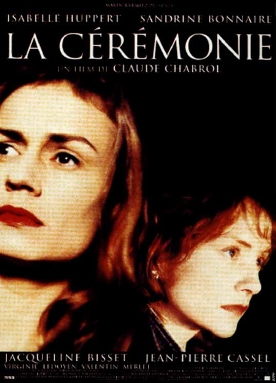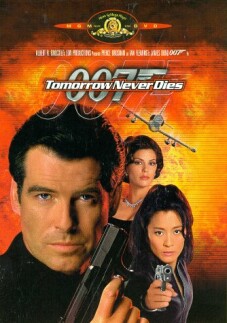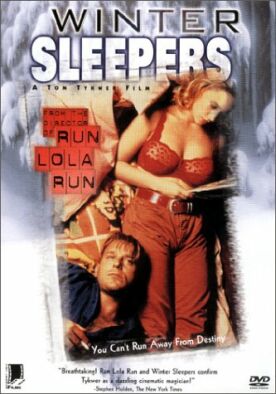Tell No One (Ne le dis à personne)
You may remember that I have written before of what a poor job Hollywood does these days with the most basic task of any popular entertainment, which is story-telling. Cinematic plotting, of the kind that used to be the backbone of mysteries, thrillers and even comedies, is now almost a lost art in American movies, where attitude and atmosphere are everything and story, at best, an afterthought. But if there should be someone in Hollywood who still recognizes the potential of tight-plotting to draw an audience, he could do worse than study Guillaume Canet’s Tell No One (Ne le dis a personne), a French film based on an American novel (with the English title) by Harlan Coben. The only problem is that the plot is just a trifle too labyrinthine and the dastardly conspiracy a little too reminiscent of American neo-noir, in which everything tends to be facilely explained by some evil rich guy and no further questions asked.
Because the plot is so central, and because it is so well done, I cannot tell very much about the movie without giving too much away. It begins with a couple, a doctor and his wife, going to a remote cabin at a lake where they have been coming since they were children. There they go for a late night swim in the nude. After a little tiff, the wife, Margot (Marie-Josée Croze) goes back to the cabin. The husband, Alex (François Cluzet) still on a raft in the middle of the lake, hears her scream. He immediately dives off the raft and swims to the dock. She screams again. He climbs onto the dock and starts to run toward her, but is immediately hit with what looks like a baseball bat and falls back into the lake. The screen goes dark. Cut to eight years later. The doctor, a pediatrician, is alive and practising, but we are given to understand that his wife was murdered, presumably on the night we have just witnessed, and that he, the doctor, was at first himself a suspect. His story was of having been knocked into the water (as we have seen he was), but it sounds suspicious in view of the fact that he was found unconscious on the dock.
Yet there had been insufficient evidence for a prosecution, and a notorious serial killer with a distinctive modus operandi (weird forms of mutilation with a knife, dead animals near the body, etc.) had been convicted of her murder, as his usual procedure had been followed. But although the serial killer had confessed to other crimes he had denied responsibility for this one. Now, the doctor starts getting e-mails that suggest she is still alive at the same time that the police are re-opening the case of her murder, since two bodies have been dug up near the murder scene, one of them with a key to Margot’s safe-deposit box in his pocket. It soon becomes clear, both to him and to us, that Alex is again under suspicion for her murder, and he has to go on the run — both from the police and from a sinister group who are watching him and remotely monitoring the messages he is getting on his computer. It takes a long time for us to find out who they are.
For what it is worth, the movie signals to us from the beginning that Alex is innocent. We see him being knocked out on the dock and into the water, just as he claims to the police he was. We also see that he misses Margot terribly and has been unable to establish a relationship with any other woman. He is naturally eager, therefore, to follow up any lead that he can which indicates that she might be alive. When the police produce photographs of her, found in the safe-deposit box along with a gun and taken before her death, with black eyes and bruises consistent with a severe beating, they again leap to the conclusion that her husband must have been the assailant. But they only spur him to undertake his own investigation — both into the photos and into the circumstances of her death — which could hardly be the act of her murderer.
He goes to talk to his father-in-law (André Dussollier), a now-retired policeman who had been the first on the scene of his own daughter’s death and had identified her body. Alex tries to quiz him about the state of the body and what she had looked like in death, but the father-in-law is extremely reluctant to talk about it and tells him to leave. Soon afterwards, he is leaping from the window of his consulting room as les flics close in.The chase sequence is extremely well done, as are the subsequent events as Alex is accused of another murder and continues his investigations into Margot’s — and her apparently secret life before her death — with the help of a criminal gang led by a wonderful low-life called Bruno (Gilles Lellouche) for whom Alex had once done a favor. To Bruno, whose sense of honor-among-thieves only the French, probably, could now portray in a movie with a straight face, this places him under an obligation to go to the limit on Alex’s behalf. I liked that part a lot, though some may find it hard to credit. In our cinematic culture, it is brutality, not honor, which conveys verisimilitude in villainy.
For the more superficial among us, myself very much included, the film also features, in minor roles, what must be the two most beautiful actresses d’un certain âge in the world, Kristin Scott Thomas and Nathalie Baye. On the negative side, the dénouement is signaled, in general terms, a bit too far in advance, and, when it finally comes, it is a little too drawn out — mainly because the sequence of events is so complicated that it takes a long time for M. Canet to explain them. Also, too much of the explanation is told rather than shown. But the director should get full credit for taking the trouble to explain them at all. Once that could have been taken for granted in any movie, but not any more. The stunning success of The Dark Knight can be seen as being, among many other things, a reminder that, in Hollywood anyway, explanations, like plots, have become superfluous.
Discover more from James Bowman
Subscribe to get the latest posts to your email.







